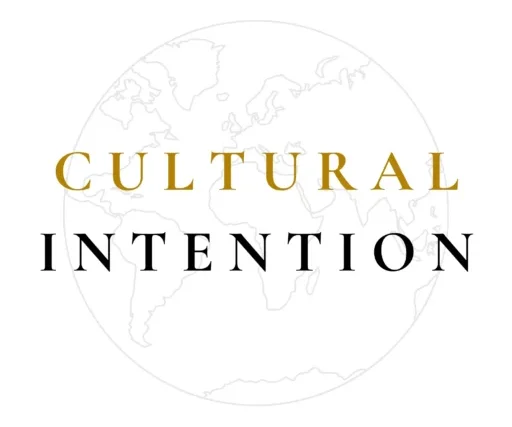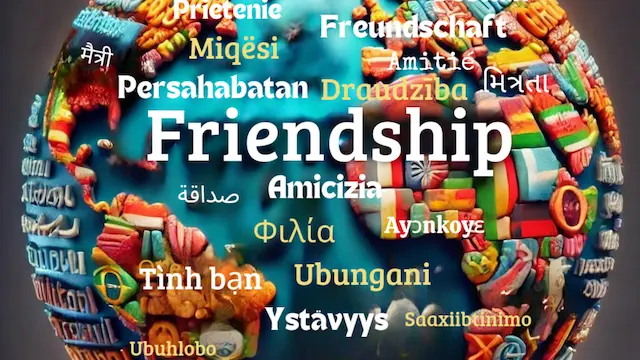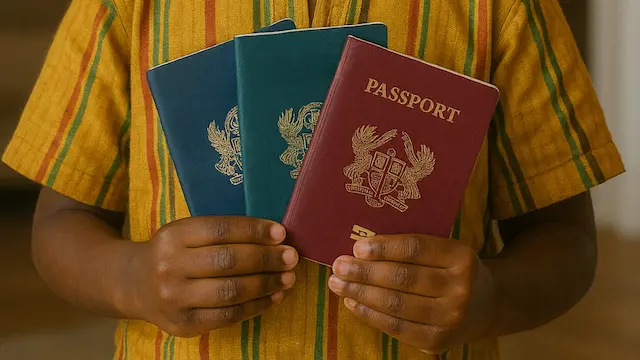Exploring 111 Unique Meanings of Queen in Different Languages
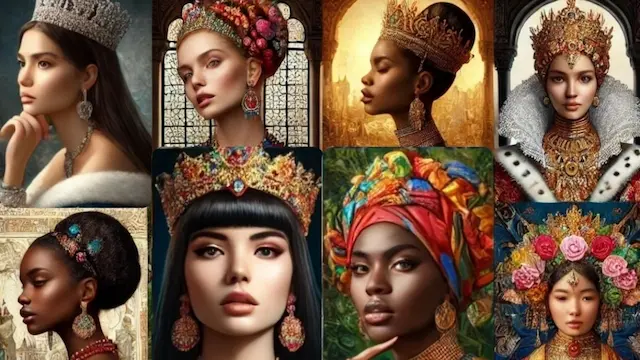
Language influences how we perceive the world, and the title Queen in Different Languages holds different meanings in different cultures.
In many languages, the word and meaning of ‘queen' vary significantly, reflecting each culture's unique values and traditions.
Exploring these differences not only expands our vocabulary but also offers insight into how this universal term is perceived both within monarchies and beyond.
From Spanish “reina” to French “reine,” each term carries a rich history.
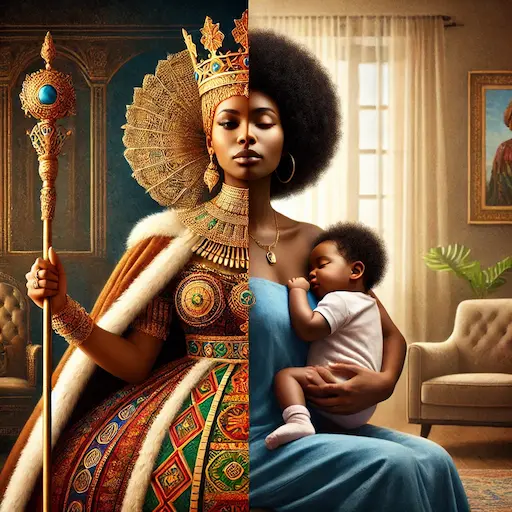
You'll find that some modern languages even have distinct terms for various types of queens, showcasing the complexity of their royal systems.
As you read through this post, you'll discover interesting connections between the language used and the social structures they represent.

Ready to Raise
Globally Minded Kids?
Download your FREE starter guide on Multicultural Learning & Language Exploration and help your children engage with the world through fun, hands-on activities.
Read with this intention in mind:
Pay attention to how the word for “queen” changes between languages yet still carries strength, leadership, or deep respect. What that role means may shift across cultures, but it often ties back to how we see dignity, care, and influence in women’s lives.
The Cultural Significance Of The Term ‘Queen' Across Different Societies
The term ‘queen' carries deep cultural meanings across various societies.
Understanding these interpretations can offer insight into the roles and attributes associated with queens, influencing perspectives on power, authority, and maternal roles.
How ‘Queen' Symbolizes Power, Authority, And Maternal Influence
In many cultures, the title of queen signifies not only regal authority but also maternal influence.
Queens often embody the ideals of leadership, nurturing, and strength.
For example, in ancient Egypt, queens like Hatshepsut ruled with significant power and often adopted male titles and roles in governance.
Similarly, in Europe, queens such as Elizabeth I exercised authority while also serving as symbolic figures of stability and continuity in their kingdoms.
The symbolic nature of queens often extends to how societies view women in leadership.
Their roles highlight the balance between nurturing and ruling, challenging traditional gender norms.
The Role Of Queens In Cultural Narratives And Symbolism
Queens are prominent figures in various cultural narratives, serving as symbols of virtue, loyalty, and justice.
In literature and folklore, they often represent ideals that societies strive to achieve.
For instance, in Arthurian legends, Queen Guinevere is depicted as a complex figure of love and loyalty, whose actions significantly impact the narrative of the court.
In Asian history, the powerful Empress Wu of China challenged societal norms and established her authority as the only female emperor, leaving a lasting legacy.
These narratives help shape societal values and expectations, illustrating the interplay between femininity and authority.
They reflect how queens navigate the spheres of power and culture, with each story or representation offering a unique perspective on their significance across different cultures.
This continues to maintain its relevance in discussions about gender and leadership today.
Queen In Different Languages
The term ‘queen' carries various meanings across different languages and regions.
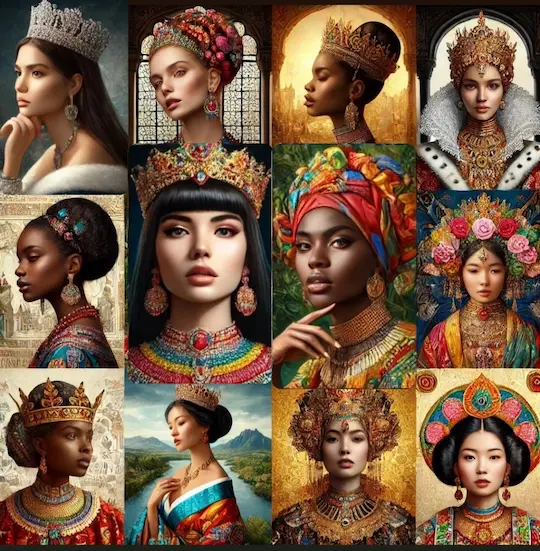
Understanding these differences helps you appreciate how societies view leadership and femininity
- Afrikaans: Koningin
- Akan (Twi): Ohemaa
- Albanian: Mbretëreshë
- Amharic: ንግሥት (Nigist)
- Arabic: ملكة (Malika)
- Aragonese: Reina
- Armenian: Թագուհի (Taguhi)
- Azerbaijani: Kraliça
- Basque: Erregina
- Belarusian: Каралева (Karaleva)
- Bemba: Balesa
- Bengali: রাণী (Rāṇī)
- Bosnian: Kraljica
- Bulgarian: Кралица (Kralitsa)
- Catalan: Reina
- Cebuano: Reyna
- Chichewa: Mfumukazi
- Chinese (Cantonese): 女王 (Neoi Wong)
- Chinese (Mandarin): 女王 (Nǚwáng)
- Corsican: Regina
- Croatian: Kraljica
- Czech: Královna
- Danish: Dronning
- Dutch: Koningin
- Dzongkha: བུམ་ཁྲིད་ (Bumthrid)
- English: Queen
- Esperanto: Reĝino
- Estonian: Kuninganna
- Finnish: Kuningatar
- French: Reine
- Frisian: Keninginne
- Galician: Raíña
- Georgian: დედოფალი (Dedofali)
- German: Königin
- Greek: Βασίλισσα (Vasilissa)
- Gujarati: રાણી (Rāṇī)
- Haitian Creole: Rèn
- Hausa: Sarauniya
- Hawaiian: Mōʻī Wahine
- Hebrew: מלכה (Malka)
- Hindi: रानी (Rani)
- Hmong: Poj Vaj
- Hungarian: Királynő
- Icelandic: Drottning
- Igbo: Eze Nwanyi
- Indonesian: Ratu
- Irish: Banríon
- Italian: Regina
- Japanese: 女王 (Joō)
- Javanese: Ratu
- Kannada: ರಾಣಿ (Rāṇi)
- Kazakh: Патшайым (Patshaıym)
- Khmer: ស្តេចស្រី (Sdach Srey)
- Kinyarwanda: Umwamikazi
- Korean: 여왕 (Yeowang)
- Kurdish (Kurmanji): Şahî
- Kyrgyz: Ханышайым (Khanıshayım)
- Lao: ພຣະນາງ (Phra Nang)
- Latvian: Karaliene
- Lithuanian: Karalienė
- Luxembourgish: Kinnigin
- Macedonian: Кралица (Kralitsa)
- Malagasy: Mpanjakavavy
- Malay: Ratu
- Malayalam: റാണി (Rāṇi)
- Maltese: Reġina
- Maori: Kuīni
- Marathi: राणी (Rāṇī)
- Mongolian: Хатан (Khatan)
- Nepali: रानी (Rāṇī)
- Norwegian: Dronning
- Oromo: Mootii Dubartii
- Pashto: ملکه (Malka)
- Persian: ملکه (Malakeh)
- Polish: Królowa
- Portuguese: Rainha
- Punjabi: ਰਾਣੀ (Rāṇī)
- Romanian: Regină
- Russian: Королева (Koroleva)
- Samoan: Masiofo
- Sanskrit: राणी (Rāṇī)
- Scots Gaelic: Banrigh
- Serbian: Краљица (Kraljica)
- Shona: Mambokadzi
- Sinhala: රැජින (Rajina)
- Slovak: Kráľovná
- Slovenian: Kraljica
- Somali: Boqorad
- Spanish: Reina
- Sundanese: Ratu
- Swahili: Malkia
- Swedish: Drottning
- Tagalog: Reyna
- Tajik: Малика (Malika)
- Tamil: ராணி (Rāṇi)
- Telugu: రాణి (Rāṇi)
- Thai: ราชินี (Ratchinee)
- Tigrinya: ንግሥት (Nigiṣiti)
- Tongan: Kuini
- Turkish: Kraliçe
- Turkmen: Patyşa
- Ukrainian: Королева (Koroleva)
- Urdu: رانی (Rani)
- Uzbek: Qirolich
- Vietnamese: Hoàng hậu
- Welsh: Brenhines
- Wolof: Lingeer
- Xhosa: Indlovukazi
- Yiddish: קעניגין (Kenigin)
- Yoruba: Ayaba
- Zulu: Indlovukazi
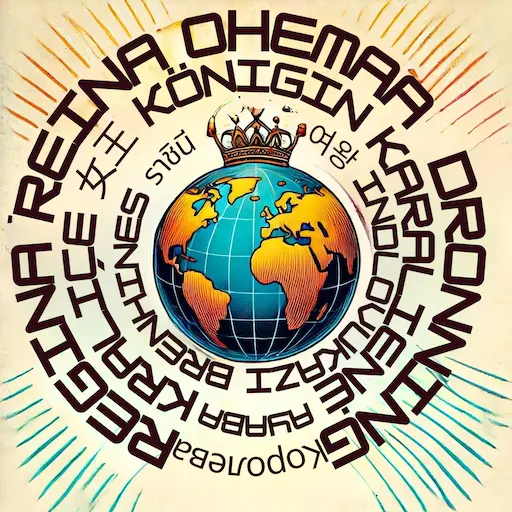
How many did you recognize? Share in the comments below, and let us know if there are any other languages or meanings of ‘queen' that surprised you!
A Deep Dive Into European Languages
In European languages, the word for “queen” often carries similar roots, reflecting shared histories by a female sovereign.
- Spanish: The word is reina, rooted in Latin.
- French: Reine shares a Latin origin, referring to a woman of royal stature.
- German: Königin comes from Old High German, reflecting nobility.
In Eastern Europe, the Russian term for queen is королева (koroleva).
This word, rooted in Slavic language traditions, retains its royal connotation while reflecting the influence of historical naming conventions.
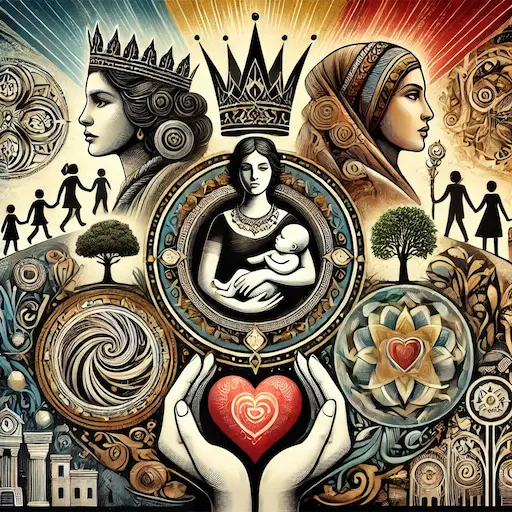
The Representation Of ‘Queen' In Asian And African Languages
In Asian languages, the term for ‘queen' varies widely due to cultural contexts:
- Arabic: The word is ملكة (malika), used to refer to a queen in various contexts.
- Hindi: The term रानी (rani) signifies the role of a queen or princess.
- Chinese: The character 女王 (nǚwáng) directly translates to ‘female king' or ‘queen.'
For African native languages, the diversity continues:
- Swahili: The term is malkia, symbolizing both dignity and leadership.
- Amharic: It uses ንግሥት (nɨgɨsǝt), emphasizing status.
Each language reflects not only the term but also its societal implications in different cultures and among different native speakers.
The global and regional variations present rich cultural tapestries and varied perceptions of royalty.
👑 Famous Queens Around the World
Throughout history, queens have ruled kingdoms, led resistance movements, built alliances, and shaped the legacies of their nations.
From Africa to Europe to Asia and beyond, here are some of the most well-known queens across different cultures — each powerful in her own right.
🌍 African Queens
- 🇪🇬 Nefertiti (Egypt)
Renowned for her beauty and power, Queen Nefertiti ruled alongside Pharaoh Akhenaten during a religious revolution. - 🇪🇹 Makeda (Queen of Sheba – Ethiopia/Eritrea)
Celebrated in Ethiopian history and religious texts, known for her legendary visit to King Solomon. - 🇸🇩 Amanirenas (Kush – Sudan)
A fierce kandake (queen mother) who defended Nubia against Roman invasion. - 🇳🇬 Queen Amina (Zazzau – Nigeria)
Hausa warrior queen who expanded her territory and strengthened trade routes. - 🇦🇴 Queen Nzinga (Ndongo & Matamba – Angola)
Skilled in diplomacy and warfare, she resisted Portuguese colonization. - 🇬🇭 Yaa Asantewaa (Ashanti – Ghana)
Queen Mother of Ejisu, who led a rebellion against British rule in the Gold Coast. - 🇿🇦 Queen Nandi (Zulu – South Africa)
Mother of Shaka Zulu, remembered for her resilience and role in shaping the Zulu nation. - 🇪🇹 Empress Taytu Betul (Ethiopia)
Strategist and co-leader at the Battle of Adwa, helped defend Ethiopia from colonization. - 🇲🇬 Queen Ranavalona I (Merina Kingdom – Madagascar)
Known for her strong and controversial rule, resisting European influence.
🌏 Asian Queens and Empresses
- 🇮🇳 Rani Lakshmibai (Jhansi – India)
A symbol of resistance during India’s first war of independence in 1857. - 🇨🇳 Wu Zetian (Tang Dynasty – China)
The only female emperor in Chinese history, she was known for her political skill and bold leadership. - 🇯🇵 Empress Suiko (Japan)
Japan’s first recorded empress, known for promoting Buddhism.
🌍 European Queens
- 🇬🇧 Queen Elizabeth I (England)
The Virgin Queen, who led during the Elizabethan era, was known for her intelligence and leadership. - 🇫🇷 Marie Antoinette (France)
An iconic and controversial queen during the French Revolution. - 🇷🇺 Catherine the Great (Russia)
Expanded Russian territory and promoted the arts and education. - 🇪🇸 Isabella I of Castile (Spain)
United Spain through marriage and sponsored Christopher Columbus’s voyage.
🌎 Queens of the Americas
- 🇲🇽 Lady Six Sky (Naranjo – Maya Civilization)
A powerful Maya queen who ruled and influenced significant architectural and cultural developments. - 🇵🇪 Mama Huaco (Inca Empire – Peru)
A legendary queen and warrior often cited as a co-founder of the Inca dynasty.
🌐 Why This Matters
Many of these women weren’t just figureheads — they ruled with strength, diplomacy, and wisdom. Their stories break the mold of what leadership has traditionally looked like, reminding us that queenship can come in many forms — from warriors to peacemakers, mothers to monarchs.

How The Title ‘Queen' Varies By Social, Cultural, And Familial Context
The name ‘queen' goes beyond its royal meaning, taking on various social and cultural interpretations.
Its meaning can vary significantly depending on the context, reflecting familial roles and cultural influences.
From Monarchs To Matriarchs: The Broader Use Of The Term ‘Queen'
In many cultures, “queen” signifies more than a royal title. It can refer to a matriarch within a family or community, representing authority and respect.
For example, in some African cultures, the term refers to the chief's wife or Queen consort, representing leadership alongside her husband.
The Modern Interpretation Of ‘Queen' In Global Pop Culture And Communities
In contemporary contexts, especially within pop culture, ‘queen' has taken on multifaceted meanings.
It often refers to strong, successful, and independent women who command respect and admiration.
This concept is common in music and social media, where figures like Beyoncé and RuPaul have popularized the term, encouraging empowerment and making the word a staple in daily use.

Cultural events prominently feature the word, celebrating identity and community.
The connection creates a sense of belonging and pride, allowing individuals to embrace their uniqueness as confident and beautiful queens.
However, some people take offense when the word ‘queen' is used loosely or applied to everyone, feeling that it should be reserved for those who truly embody its qualities.
This reaction highlights the diversity of interpretations and the evolving nature of the term ‘queen' across different cultures and contexts, especially when phrases like ‘yas queen' are used.
Usage trends in entertainment, auto, and beauty continually evolve, reflecting societal changes and allowing the term to resonate with reassurance and confidence.
The Influence Of The Term ‘Queen' On Naming Practices
The term ‘queen' carries significant weight in naming practices across cultures.
Its influence can be seen in how families choose names for their daughters and in cultural legacies tied to historical figures.
From Royalty To Namesakes: How ‘Queen' Is Used As A Name For Daughters
Many parents choose to use ‘Queen' as a name for their daughters, reflecting a desire to give strength and dignity.
This choice often symbolizes high esteem and aspirations for their child.
Variations of the name ‘Queen' include:
- Queenie: A diminutive form often used as a nickname.
- Regina: A Latin name meaning ‘queen.'
- Raina/Reina: Variants meaning ‘queen' in different languages.

These variations maintain the essence of royalty while allowing for personal interpretation.
Naming a child after a queen or using the title itself often signifies admiration for qualities such as leadership and grace.
In our home, we have quite a few ‘queens,' and it has become a cherished tradition to name our girls after ‘Queen.'
Parents often choose these names to inspire their daughters to embrace their power and potential.
The Legacy Of Queens In Family Names And Traditions
Family names often reflect historical queens or strong female figures, adding rich context to cultural heritage.
This connection creates a sense of pride and continuity within families.
Examples include:
- Elizabeth (after Queen Elizabeth II)
- Victoria (after Queen Victoria)
Many traditions involve passing down names associated with queens, connecting generations, and reinforcing ideals of strength and resilience.
Naming children after admired queens serves as a meaningful legacy, carrying forward values from one generation to the next.

In Ashanti culture, the title Ohemaa is not just a name but a symbol of female leadership and strength.
Many in the Ashanti tradition are named Ohemaa to honor and preserve this legacy.
A unique aspect of the Ashanti Kingdom is its matrilineal system, where the next king is always chosen from the male relatives of the queen, rather than from the king's own descendants.
Naming children after admired queens, or giving them a name that literally means “queen,” such as Ohemaa, serves as a meaningful legacy, carrying forward values from one generation to the next.
This practice reinforces ideals of strength, resilience, and the significance of these figures, ensuring their cultural importance is remembered and honored over time.
We are all queens, wearing our crowns of courage, wisdom, and grace in our own unique ways.” — Faith Achiaa
Exploring the word ‘queen' across various languages reveals cultural richness and diversity. Each name translation carries its own nuances and historical significance.
Understanding these variations can deepen your appreciation for different cultures. It highlights how language connects us to shared values of respect and leadership.
Reflect on how the concept of a queen varies in importance and influence around the world.
These differences offer insight into societal structures and traditions, showcasing the unique ways in which each culture honors its leaders.
Celebrate these connections through language. By learning the translations, you gain a greater appreciation for the role of queens throughout history and in modern times.
Embrace the strength and grace that each term represents, and remember that we all have the potential to embody the spirit of a queen in our own lives.
Stay regal, stay empowered.
IF THIS POST SPOKE TO YOU, EXPLORE MORE OF THE JOURNEY ON OUR SITE.
You'll find free guides, intentional tools, and reflections to support cultural growth and legacy-building.
💬 Looking for connection? Join our Facebook community to continue the conversation.
📌 Pin an image to revisit or share with someone walking a similar path.
Thank you for being here.



